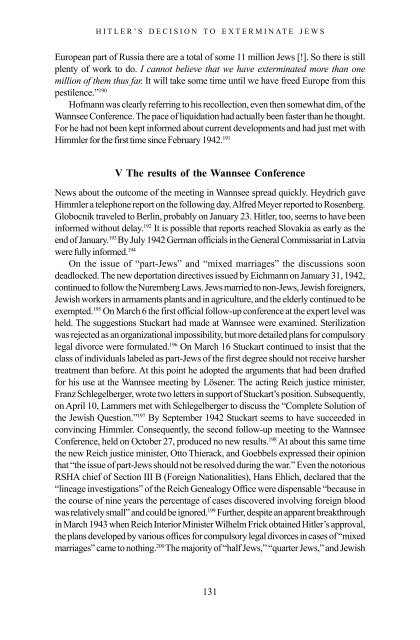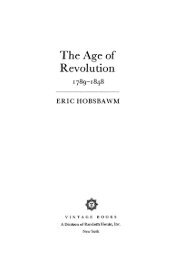The_Holokaust_-_origins,_implementation,_aftermath
The_Holokaust_-_origins,_implementation,_aftermath
The_Holokaust_-_origins,_implementation,_aftermath
You also want an ePaper? Increase the reach of your titles
YUMPU automatically turns print PDFs into web optimized ePapers that Google loves.
HITLER’S DECISION TO EXTERMINATE JEWS<br />
European part of Russia there are a total of some 11 million Jews [!]. So there is still<br />
plenty of work to do. I cannot believe that we have exterminated more than one<br />
million of them thus far. It will take some time until we have freed Europe from this<br />
pestilence.” 190<br />
Hofmann was clearly referring to his recollection, even then somewhat dim, of the<br />
Wannsee Conference. <strong>The</strong> pace of liquidation had actually been faster than he thought.<br />
For he had not been kept informed about current developments and had just met with<br />
Himmler for the first time since February 1942. 191<br />
V <strong>The</strong> results of the Wannsee Conference<br />
News about the outcome of the meeting in Wannsee spread quickly. Heydrich gave<br />
Himmler a telephone report on the following day. Alfred Meyer reported to Rosenberg.<br />
Globocnik traveled to Berlin, probably on January 23. Hitler, too, seems to have been<br />
informed without delay. 192 It is possible that reports reached Slovakia as early as the<br />
end of January. 193 By July 1942 German officials in the General Commissariat in Latvia<br />
were fully informed. 194<br />
On the issue of “part-Jews” and “mixed marriages” the discussions soon<br />
deadlocked. <strong>The</strong> new deportation directives issued by Eichmann on January 31, 1942,<br />
continued to follow the Nuremberg Laws. Jews married to non-Jews, Jewish foreigners,<br />
Jewish workers in armaments plants and in agriculture, and the elderly continued to be<br />
exempted. 195 On March 6 the first official follow-up conference at the expert level was<br />
held. <strong>The</strong> suggestions Stuckart had made at Wannsee were examined. Sterilization<br />
was rejected as an organizational impossibility, but more detailed plans for compulsory<br />
legal divorce were formulated. 196 On March 16 Stuckart continued to insist that the<br />
class of individuals labeled as part-Jews of the first degree should not receive harsher<br />
treatment than before. At this point he adopted the arguments that had been drafted<br />
for his use at the Wannsee meeting by Lösener. <strong>The</strong> acting Reich justice minister,<br />
Franz Schlegelberger, wrote two letters in support of Stuckart’s position. Subsequently,<br />
on April 10, Lammers met with Schlegelberger to discuss the “Complete Solution of<br />
the Jewish Question.” 197 By September 1942 Stuckart seems to have succeeded in<br />
convincing Himmler. Consequently, the second follow-up meeting to the Wannsee<br />
Conference, held on October 27, produced no new results. 198 At about this same time<br />
the new Reich justice minister, Otto Thierack, and Goebbels expressed their opinion<br />
that “the issue of part-Jews should not be resolved during the war.” Even the notorious<br />
RSHA chief of Section III B (Foreign Nationalities), Hans Ehlich, declared that the<br />
“lineage investigations” of the Reich Genealogy Office were dispensable “because in<br />
the course of nine years the percentage of cases discovered involving foreign blood<br />
was relatively small” and could be ignored. 199 Further, despite an apparent breakthrough<br />
in March 1943 when Reich Interior Minister Wilhelm Frick obtained Hitler’s approval,<br />
the plans developed by various offices for compulsory legal divorces in cases of “mixed<br />
marriages” came to nothing. 200 <strong>The</strong> majority of “half Jews,” “quarter Jews,” and Jewish<br />
131



